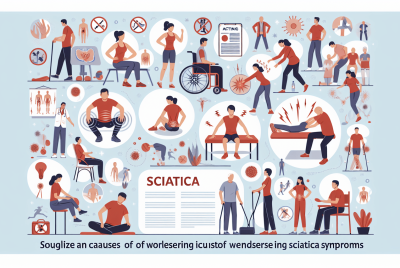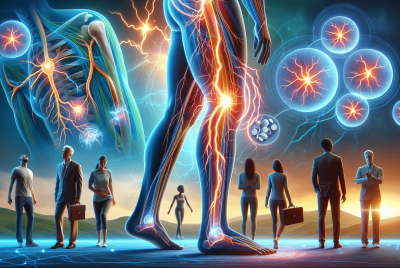How To Relieve Back Pain With Stretching Exercises
Are you tired of dealing with nagging back pain that seems to never go away? Look no further than simple stretching exercises to find relief. In this article, you will discover effective ways to alleviate back pain by incorporating a variety of stretching exercises into your daily routine. Whether you’re a desk worker, an athlete, or someone who simply suffers from occasional back pain, these exercises will help improve flexibility, release tension, and ultimately provide the much-needed relief you’ve been seeking. Say goodbye to back pain and hello to a pain-free, more active lifestyle.
Preventing back pain
Maintaining good posture is essential for preventing back pain. When you sit or stand, make sure to keep your back straight and shoulders relaxed. Avoid slouching or hunching forward, as this can put strain on your back muscles and spine. Additionally, be mindful of your posture when lifting heavy objects or performing any physical activity. By maintaining good posture, you can significantly reduce the risk of developing back pain.
Regular exercise is another crucial component in preventing back pain. Engaging in activities that strengthen the muscles in your back, abdomen, and legs can help provide support to your spine. Incorporate exercises such as walking, swimming, or cycling into your routine to improve your overall fitness and strengthen your back muscles. Remember to start slowly and gradually increase the intensity and duration of your workouts.
Using proper lifting techniques is vital for preventing back pain, especially when it comes to heavy lifting. Always bend your knees and lift with your legs rather than your back. Keep the object close to your body and avoid twisting or jerking motions while lifting. If an object is too heavy, don’t hesitate to ask for assistance. By following these lifting techniques, you can protect your back from unnecessary strain and potential injuries.
Taking breaks when you have been sitting or standing for extended periods is essential for preventing back pain. Prolonged periods of inactivity can lead to muscle stiffness and tension, which can contribute to back pain. Take regular breaks to stretch, walk around, or change your posture. Incorporating small movements and stretching exercises throughout the day can help alleviate muscle tightness and maintain the flexibility of your spine.
Understanding the benefits of stretching
Stretching is not only a great way to relieve back pain, but it also offers numerous other benefits. By incorporating stretching exercises into your daily routine, you can experience increased flexibility, improved muscle strength, enhanced blood circulation, and reduced muscle tension.
Stretching helps increase flexibility by lengthening the muscles and improving their range of motion. When your muscles are properly stretched, you are less likely to experience muscle stiffness and tightness, which can lead to back pain. By regularly stretching, you can maintain and improve flexibility, making your body more resilient to everyday activities.
In addition to increasing flexibility, stretching exercises also help improve muscle strength. When you stretch, your muscles undergo controlled stretching, which aids in strengthening them. Stronger muscles provide better support to your spine, reducing the risk of strain and injury. Incorporating regular stretching into your routine can help you develop a strong core and back muscles, providing stability to your spine.
Stretching promotes better blood circulation throughout your body. As you stretch, blood flow increases to the stretched muscles, providing them with essential nutrients and oxygen. Improved blood circulation helps promote healing and reduces muscle soreness, enabling faster recovery from back pain. It also helps maintain the health of your spine and surrounding tissues.
One of the significant benefits of stretching is the reduction of muscle tension. Prolonged muscle tension can lead to discomfort and stiffness, contributing to back pain. Stretching helps relax and release tension from the muscles, relieving any tightness or knots that may have developed. By incorporating stretching exercises into your routine, you can alleviate muscle tension and promote a sense of relaxation and well-being.
Identifying the causes of back pain
Understanding the causes of back pain is crucial in effectively addressing and preventing it. Some common causes of back pain include muscle strains, herniated discs, spinal stenosis, and degenerative disc disease.
Muscle strains are a prevalent cause of back pain and occur when the muscles in the back are overstretched or torn. This can happen due to sudden movements, lifting heavy objects incorrectly, or poor posture. Muscle strains can range from mild to severe, causing varying levels of pain and discomfort.
Herniated discs, also known as slipped discs or ruptured discs, occur when the cushions between the vertebrae in the spine become damaged or bulge out of place. This can put pressure on nearby nerves, leading to back pain. Herniated discs can result from aging, wear and tear, or sudden injuries.
Spinal stenosis refers to the narrowing of the spaces within the spine, which can put pressure on the nerves and cause back pain. This condition often occurs due to the natural aging process or can be a result of previous injuries or other underlying medical conditions.
Degenerative disc disease refers to the gradual degradation of the discs in the spine over time, leading to back pain and discomfort. This condition is commonly associated with aging, although it can also result from repetitive movements, poor posture, or previous injuries.

Choosing the right stretches for back pain relief
When it comes to relieving back pain through stretching exercises, it is essential to choose the right stretches that target the specific areas of discomfort. Here are some stretches that can help alleviate back pain:
Hamstring stretches are beneficial for relieving lower back pain. Tight hamstrings can contribute to back pain by placing additional stress on the lower back. Incorporating hamstring stretches into your routine can help improve flexibility and reduce strain on the lower back.
Hip stretches are also effective in relieving back pain, particularly in the lower back and hips. Tight hip muscles can cause imbalances in the body, leading to increased pressure on the back. By stretching the hip muscles, you can alleviate tension and promote proper alignment.
Lower back stretches specifically target the muscles in the lower back, providing relief from pain and discomfort. These stretches help improve flexibility and strengthen the muscles that support the spine.
Lumbar rotation stretches are beneficial for releasing tension in the lower back and improving mobility. These stretches involve twisting movements that gently stretch the muscles in the lumbar region, promoting flexibility and reducing stiffness.
Performing hamstring stretches
Hamstring stretches are an effective way to relieve lower back pain. Here are some common hamstring stretches:
The standing hamstring stretch is performed by standing tall with your feet hip-width apart. Extend one leg in front of you, keeping it straight, and hinge forward at the hips, reaching towards your toes. Hold this stretch for 20-30 seconds, then switch to the other leg.
The seated hamstring stretch is done by sitting on the edge of a chair and extending one leg out in front of you. Lean forward, reaching towards your toes, and hold this stretch for 20-30 seconds. Repeat with the other leg.
The supine hamstring stretch is performed by lying on your back with both legs extended. Lift one leg towards the ceiling, keeping it straight, and gently pull it towards your chest using a towel or strap. Hold for 20-30 seconds, then switch legs.
By incorporating these hamstring stretches into your routine, you can reduce muscle tension and alleviate lower back pain.
Practicing hip stretches
Hip stretches can help relieve back pain by targeting the muscles in the lower back and hips. Here are some hip stretches you can incorporate into your routine:
The pigeon pose is an effective stretch for the hips. Begin in a plank position and bring one knee forward, placing it behind the wrist on the same side. Extend the other leg behind you and lower your body towards the ground, feeling a stretch in the hip of the extended leg. Hold for 20-30 seconds, then switch sides.
The seated figure four stretch is performed by sitting on the edge of a chair and crossing one ankle over the opposite knee. Gently press down on the raised knee, feeling the stretch in the hip of the crossed leg. Hold for 20-30 seconds, then switch sides.
Lunges are also beneficial for stretching the hip muscles. Take a step forward with one foot and lower your body into a lunge position, keeping your back straight and pelvis slightly tilted forward. Hold for 20-30 seconds, then switch sides.
By regularly practicing these hip stretches, you can alleviate tension in the lower back and hips, reducing back pain and promoting overall flexibility.
Doing lower back stretches
Lower back stretches are specifically designed to target the muscles in the lower back, providing relief from pain and discomfort. Here are some common lower back stretches:
The child’s pose is a gentle stretch that helps relax the muscles in the lower back. Start on your hands and knees, then sit back on your heels while keeping your arms extended in front of you. Rest your forehead on the ground and hold this stretch for 20-30 seconds.
The cat-cow stretch is done by starting on your hands and knees, with your back straight. As you inhale, arch your back and lift your head up, creating a gentle backbend (cow pose). As you exhale, round your back and let your head drop (cat pose). Repeat this movement for several breaths, focusing on the stretch in your lower back.
The superman stretch is performed by lying face down on the ground and extending your arms and legs. Lift your chest, arms, and legs off the ground, feeling the stretch in your lower back. Hold this position for 20-30 seconds, then lower down.
Incorporating these lower back stretches into your routine can help alleviate tension and improve flexibility in the muscles of your lower back.
Engaging in lumbar rotation stretches
Lumbar rotation stretches can help release tension in the lower back and improve mobility. Here are some lumbar rotation stretches you can try:
The knee-to-chest stretch is performed by lying on your back with your knees bent and feet flat on the ground. Bring one knee towards your chest and hold it with both hands, gently pulling it closer. Hold this stretch for 20-30 seconds, then switch legs.
The spinal twist stretch is done by lying on your back with your knees bent and feet flat on the ground. Extend your arms out to the sides, then lower your knees to one side, keeping your shoulders on the ground. Hold this stretch for 20-30 seconds, then switch sides.
The seated spinal rotation stretch is performed by sitting on the edge of a chair with your feet flat on the ground. Place one hand on the opposite thigh and gently twist your upper body towards that side, looking over your shoulder. Hold this stretch for 20-30 seconds, then switch sides.
By engaging in these lumbar rotation stretches, you can reduce stiffness and improve the flexibility of your lower back.
Correct stretching techniques
To maximize the effectiveness of your stretching exercises and prevent injuries, it is essential to follow correct stretching techniques. Here are some tips to keep in mind:
Warm up before stretching by engaging in light activity such as walking or cycling for a few minutes. This helps increase blood flow to the muscles and prepares them for stretching.
Stretch both sides equally to ensure balance and symmetry in your body. Avoid focusing on one side more than the other, as this can lead to imbalances and potential issues in the long run.
Do not bounce during the stretch. Bouncing can cause the muscles to tighten and increase the risk of injury. Instead, stretch slowly and hold the position without any sudden movements.
Breathe deeply and relax while stretching. Deep breathing helps oxygenate the muscles and promotes relaxation, allowing for a deeper stretch and better overall experience.
By following these stretching techniques, you can safely and effectively stretch your muscles, promoting flexibility and preventing injuries.
Incorporating stretching into your daily routine
To experience the full benefits of stretching, it is essential to incorporate it into your daily routine. Here are some ways you can incorporate stretching based on different times of the day:
Morning stretches can help wake up your body and prepare it for the day ahead. Spend a few minutes stretching your entire body, focusing on areas prone to tension or tightness.
Before exercise stretches are crucial for warming up your muscles and preventing injuries. Perform dynamic stretches that involve movement, focusing on the specific muscles and joints you will be using during your workout.
After exercise stretches are essential for cooling down your body and aiding in muscle recovery. Perform static stretches, holding each stretch for 20-30 seconds, targeting the muscles you used during your workout.
Stretches for sedentary individuals are vital for those who spend long hours sitting or have a sedentary lifestyle. Take short breaks throughout the day to stretch and move your body, focusing on areas such as the neck, shoulders, lower back, and hips.
By incorporating stretching into your daily routine, you can optimize its benefits and promote overall well-being.
In conclusion, preventing back pain requires maintaining good posture, exercising regularly, using proper lifting techniques, and taking breaks when sitting or standing for long periods. Stretching is an effective way to relieve back pain, increase flexibility, improve muscle strength, enhance blood circulation, and reduce muscle tension. Understanding the causes of back pain, such as muscle strains, herniated discs, spinal stenosis, and degenerative disc disease, can help identify the appropriate stretches for relief. Choosing the right stretches for specific areas, such as hamstrings, hips, lower back, and lumbar rotation, can provide targeted pain relief. By following correct stretching techniques and incorporating stretching into your daily routine, you can effectively alleviate back pain and promote overall back health. So, start incorporating stretching exercises into your routine and say goodbye to back pain for good!




